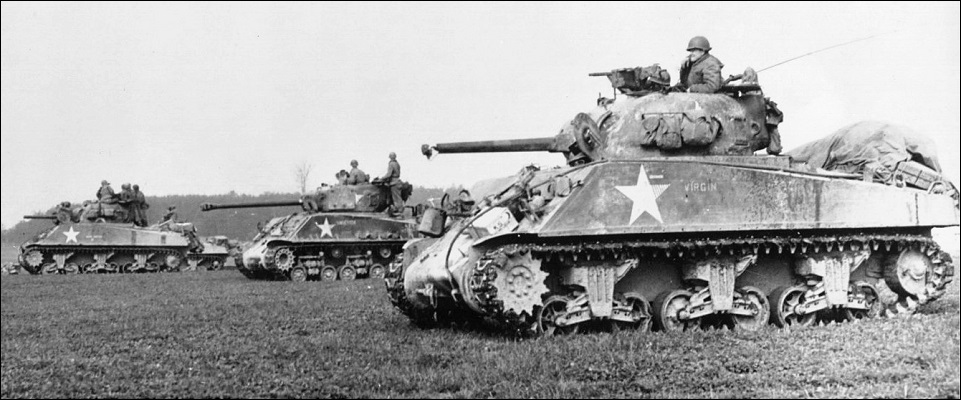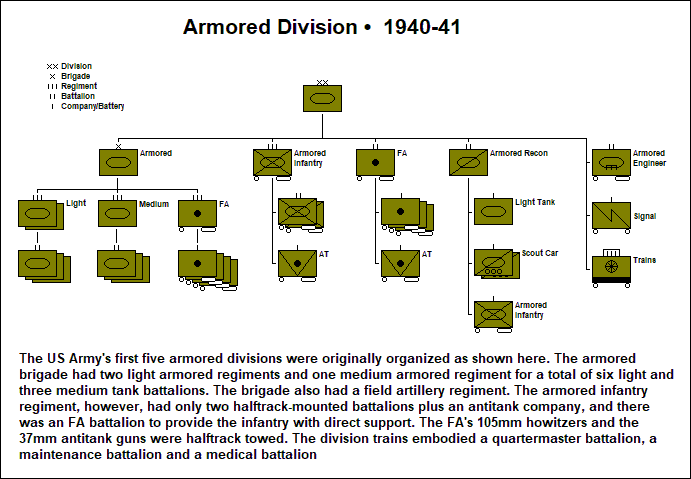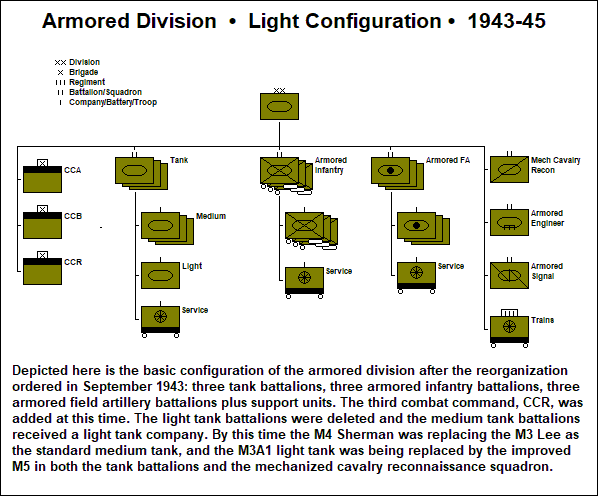After
World War I the US Army classified the tank as an
infantry support weapon: The wartime Tank Corps was
disbanded and the Army's two heavy and four light tank
battalions were subordinated to the Infantry branch. Thus
the first steps toward the creation of mechanized combat
formations occurred in the Cavalry branch. Recognizing that
the days of horse cavalry were numbered, in 1931 the Chief
of Staff, General Douglas McArthur, directed the Cavalry to
pursue the development of armored combat vehicles. The Chief
of Staff's directive was part of a broader initiative to
mechanize the Army, though lack of funding limited its
effectiveness. It was not until 1940 that the Armored Force
was provisionally established as a separate Army branch, by
which time the war in Europe had clearly demonstrated the
need for large armored formations combining tanks with
infantry, artillery and other support units. Thus on 15 July
1940 the Army activated the 1st Armored Division by
expanding and reflagging the 7th Cavalry Brigade
(Mechanized).
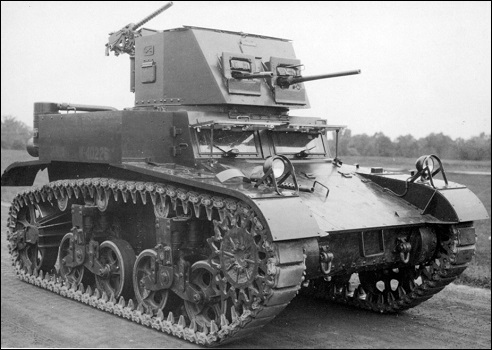
The US Army's first modern light
tank, the M1 Combat Car (later redesignated as
the M1A1 Light Tank), entered service with the
Cavalry in 1937. It was armed with one caliber
.50 and three caliber .30 machine guns. (War
Department photo)
At the
time of America's entry into World War II the United States
Army had five armored divisions plus a number of
independent tank battalions, all grouped under the
Armored Force, which was now designated as an army-echelon
command. In 1943 it was renamed the Armored Command and its
status as an Army branch was formalized. By then there were
sixteen armored divisions in existence: a considerably
smaller number than initially planned, this thanks to the
decision to limit the total size of the wartime Army to 90
combat divisions. Additionally there were 70 independent
tank battalions.
Early
on, two types of armored formations were envisioned: the
armored division and the tank (later armored) group. The
former included infantry, field artillery (FA) and other
support units and was intended for offensive operations; the
latter had only three or four tank battalions and was
intended to support the infantry. However, combat experience
revealed that the group concept was flawed and instead the
non-divisional tank battalions were directly attached to
infantry divisions. By 1944 almost every infantry division
in Europe had an attached tank battalion, while the armored
group headquarters were either relegated to administrative
functions under a corps headquarters or used to form a third
combat command in the armored divisions (see below). The
separate tank battalions were organized identically to those
in the armored divisions.
The 1941
armored division embodied an armored brigade with three
armored regiments (two light, one medium) and an FA
artillery regiment plus a separate FA battalion; an armored
infantry regiment; an armored reconnaissance battalion; an
armored combat engineer battalion; and the division trains
(supply, transportation, maintenance, medical). The armored
regiments each had three battalions, for a division total of
six light and three medium battalions. The light tank was
the M3 Stuart (37mm gun plus five caliber .30 machine guns);
the medium tank was the M3 Lee (75mm gun and 37mm guns plus
two caliber .30 machine guns). Division totals were 265
light tanks and 161 medium tanks. The armored infantry
regiment, however, had only two battalions. The infantry was
mounted in armored halftracks, and these were also used as
prime movers for the division’s 105mm howitzers and 37mm
antitank guns. The armored reconnaissance battalion was
equipped with light tanks, M3A1 armored scout cars and
motorcycles.
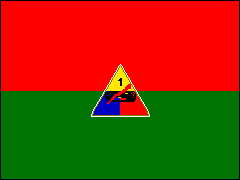
Distinguishing Flag,
1st Armored Division, displaying the
unit's shoulder sleeve insignia. This
was the same for all armored divisions
only the black numerical designation
differing.
This
tank-heavy configuration was typical of most armies’
early-war armored divisions, and it was soon realized that
more infantry was required. The armored division was
accordingly reconfigured in 1942. There were
now two armored regiments, each with one light and two
medium tank battalions for a total of 135 light tanks and
216 medium tanks, while the armored infantry regiment
acquired a third battalion. The divisional artillery
regiment was converted to a DIVARTY (division artillery)
headquarters controlling three armored FA battalions, each
with eighteen M7 self-propelled 105mm howitzers. Finally, to improve command
and control the armored brigade headquarters was replaced by two
brigade-echelon tactical headquarters, enabling the division
commander to create flexible battle groups and task forces;
they were designated Combat Command A (CCA) and Combat
Command B (CCB). The first three
armored divisions committed to combat (1st, 2nd, and
3rd) were in this configuration.
Though
the 1942 reorganization addressed most of the armored
division’s tactical shortcomings, another consideration
weighed on the minds of Army planners. This was shipping
space. After divisions were mobilized and trained, they had
to be moved by sea to the various theaters of operations.
But the conflicting demands generated by global war placed a
severe strain on shipping, a major factor in the decision to
limit the Army’s size to 90 divisions. It was also
considered imperative to lighten both infantry and armored
divisions. For that reason infantry divisions were not fully
motorized, and in 1943 the armored division was again
reorganized.
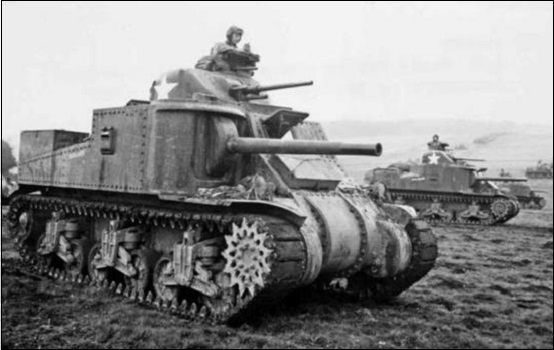
M3 Lee medium tanks in Tunisia, early
1943. Note the sponson-mounted 75mm gun and the tank's
high silhouette. Adopted for service in 1940, the M3 was
considered an interim design and by late 1943 it had
been completely replaced by the M4 Sherman. (US Army Center
of Military History)
The 1943
armored division was considerably smaller than its
predecessor, with just 564 officers and
10,052 enlisted personnel. Regimental armored and armored infantry
headquarters were abolished and the number of tank
battalions was cut from six to three. The battalions
themselves were reorganized to embody one light and three
medium tank companies. The armored reconnaissance battalion
was replaced by a
mechanized cavalry reconnaissance squadron
with light tanks and armored cars. There were now 168 medium
tanks and 72 light tanks in the division. By this time the
medium tank was the M4 Sherman (75mm gun plus one caliber
.50 and two caliber .30 machine guns) and the light tank was
the M5 Stuart (37mm gun plus three caliber .30 machine
guns). Finally, a third combat command,
designated Reserve (CCR), was added. Many of these new combat
commands were former armored and tank destroyer group
headquarters.
Fourteen of the sixteen armored divisions
were converted to the light configuration in late
1943-early 1944. Of the three armored divisions already committed to
action, the 1st, serving in Italy, was converted in 1944. The 2nd and 3rd Armored
Divisions, which were in Britain preparing for the invasion
of France, were never converted to the new “light”
configuration and were designated as “heavy.” They did,
however, receive a CCR.
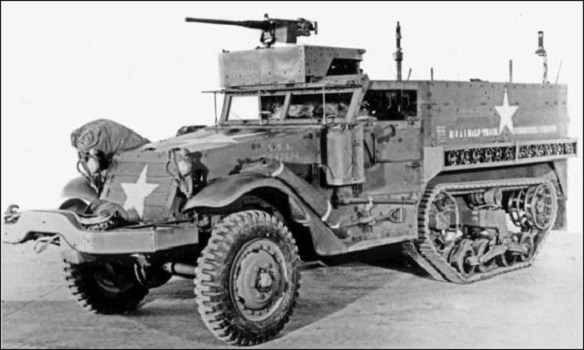
The M3 armored halftrack was an important
combat vehicle in the US armored division. The basic
model shown here could transport an armored infantry
rifle squad, and other variants mounted an 81mm mortar,
antiaircraft automatic weapons or a 75mm howitzer. (War
Department photo)
The 1943 light armored division was very
similar to the German Army’s late-war panzer division.
Superficially, indeed, they appeared quite different, since
the German division maintained a regimental structure for
its panzer and panzer grenadier (motorized or armored
infantry) battalions. The panzer division also had
Panzerjäger (antitank) and Flak (antiaircraft)
battalions—both lacking in the US division. But these
differences were more apparent than real. In practice, the
German regimental headquarters were used in the same way as
the US division’s combat commands: battalions and companies
were cross-attached to form combined-arms battle groups (Kampfgruppen).
Thus the panzer regiment might lose one of its two
battalions in exchange for a panzer grenadier battalion, an
SP antitank company, a light flak battery, etc. As for
antitank and antiaircraft assets, it was common for
SP tank
destroyer and SP antiaircraft automatic weapons battalions
to be attached to US armored divisions, which considerably
augmented their firepower.
Another interesting comparison is the US
light armored division versus the
late-war Soviet tank corps.
The latter was a division-sized unit with three tank
brigades—actually the size of a US tank battalion, albeit
with the addition of a small infantry component—and a
motorized rifle brigade of three battalions. Each tank
brigade had 65 medium tanks for a corps total of 195, as
against 168 medium and 72 light tanks in the US division.
Total infantry strength was also about the same, given the
smaller size of the Red Army's motorized rifle battalions.
The main difference between the two units was that the tank
corps had a much weaker artillery component consisting of
motor-towed 76mm guns and 120mm mortars.
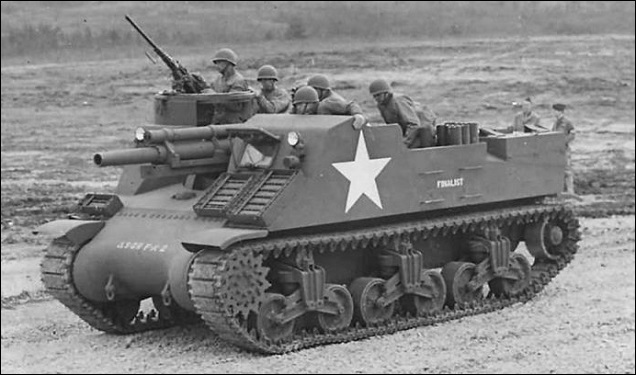
The M7 Priest self-propelled 105mm
howitzer furnished the armored division's field
artillery component: three battalions, each with
eighteen M7s.The Priest's design was based on the
chassis of the M3 medium tank. (US Army Center
of Military History)
Since
its large unit organization made no provision for armored
formations as such, there were no US Army equivalents of the
German panzer corps or panzer army, or the corps-size Soviet
tank army. When an armor-heavy
corps was desired, a typical configuration was two armored
divisions and one
infantry division, the latter fully
motorized with attached quartermaster truck companies. An
example was XIX Corps of First Army in June 1944, with the
2nd and 3rd Armored Divisions and the 30th Infantry
Division. Otherwise the usual configuration was one armored
division and up to three infantry divisions. But armored
divisions were not evenly distributed among the corps, some
of which had none.
Throughout the war, the Armored Force's mainstay was the M4
Sherman medium tank, with nearly 50,000 produced between
1942 and 1945. Up to 1943 it was a match for any tank
fielded by the German Army, but with the appearance of the
Panther medium tank and the Tiger heavy tank the Sherman
found itself at a disadvantage. Its 75mm main gun was
ineffective against the frontal armor of the Panthers and
Tigers, while its own armor was incapable of defeating their
high-velocity 75mm and 88mm rounds. Though the introduction
of the M4A3 model with thicker armor, an improved turret and a high-velocity
76mm gun narrowed the performance gap, it never completely
replaced earlier models and in any case the Sherman was a
prewar design whose development potential was limited. On
the other hand, it was available in much larger numbers than
its admittedly superior German rivals; that and proper
tactics evened the odds somewhat. Even so, tank losses were
heavy during the Battle of the Bulge, when sizeable German panzer
formations were encountered.
The need
for a heavy tank had long been clear and after protracted
development the M26 Pershing, well armored and armed with a
90mm main gun, entered production in late 1944. In terms of
armor protection and firepower it was roughly comparable to
the German Tiger I. The Pershing was intended to supplement
and eventually to replace the Sherman, but only few reached
front-line armored units before the war in Europe ended.
Postwar, it was progressively developed and its descendants,
the M48 and M60 Patton, were the mainstays of the US armored
division up to the late 1980s.
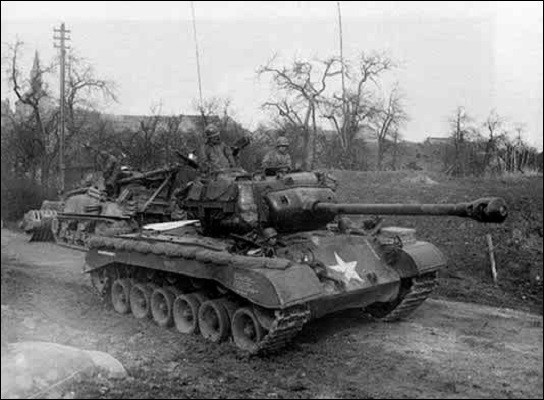
An M26 Pershing heavy tank in
Germany, spring 1945. Note the barrel length of
the 90mm main gun. In the background is an M32
armored recovery vehicle. Only a few Pershings
reached the field before the end of the war.
(Warfare History Network)
The M5
Stuart light tank with its thin armor and 37mm main gun was
no match for the German tanks it encountered from 1943
onward. But it was useful for reconnaissance and the Stuart
continued in service until the end of the war. The obvious
need for a light tank with more firepower led to the
development of the M24 Chaffee, which though lightly armored
was armed with a 75mm gun. It entered service in November
1944 and by the end of the war the Chaffee had replaced
40-50% of the Stuarts in armored and mechanized cavalry
units.
All US
armored divisions served in the European theater of
operations. Of the 70 separate armored battalions, 50 served
in the ETO and the rest went to the Pacific, where they
served primarily in the infantry support role. For the
projected invasion of Japan, two armored divisions, the 13th
and 20th, were allotted to the XIII Corps of First Army,
which was to be redeployed to the PTO for Operation Coronet,
the assault on Honshu, the largest of the Japanese Home
Islands. But the atomic bomb ended the war before this
redeployment got underway.
With the
end of the war, all armored divisions but the 2nd were
inactivated, though the 1st, 3rd, and 4th were reactivated in the late 1940s and early 1950s. The 4th was
once more inactivated in 1971, but the other three remained
in the Army’s force structure up to the end of the Cold War.
From 1953 to 1963 there was also a single armored group,
stationed in Germany, with three tank battalions and an
armored infantry battalion. Of these units, only the 1st
Armored Division, “Old Ironsides,” remains today.
The
postwar armored divisions were organized similarly to the
wartime light armored division, albeit with a fourth tank
battalion, a fourth armored infantry battalion and a fourth
FA battalion. The combat commands were ultimately
redesignated as brigades, but this did not affect the basic
divisional organization, which survived until the Army’s
adoption in 2006 of the current modular combat brigade
organization.
